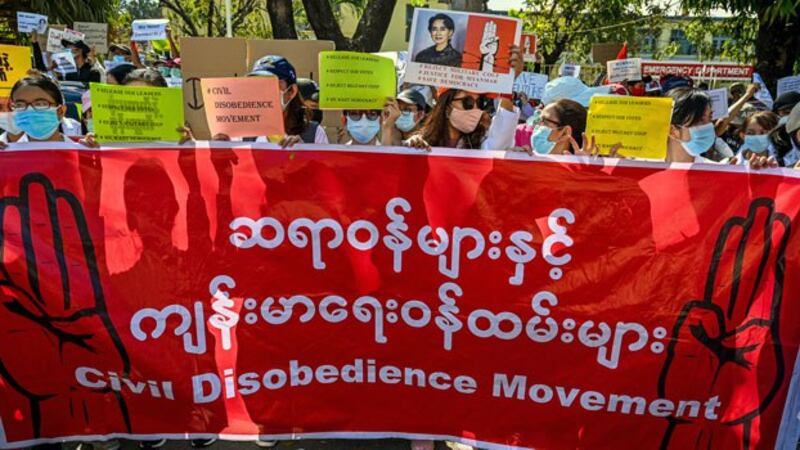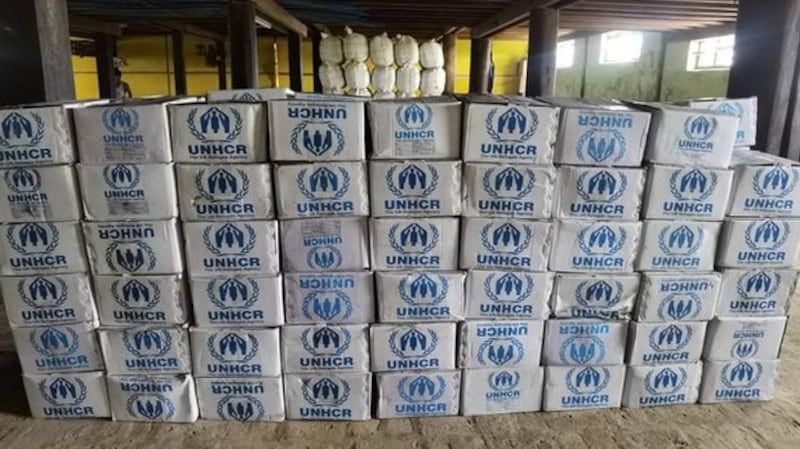At least 30 people confirmed to be infected with COVID-19 are in hiding in the jungles of Myanmar’s remote Sagaing region after fleeing fighting between troops loyal to the country’s military regime and a branch of the People’s Defense Force (PDF) militia, residents said Thursday.
The patients had been receiving medical treatment at two donor-funded COVID-19 centers in Kalay township’s Ashaysee and Tinthar villages but were forced to vacate the area along after clashes broke out between junta forces and members of the Kalay PDF on July 15, according to a villager who spoke to RFA’s Myanmar Service on condition of anonymity, citing fear of reprisal.
Hundreds of junta reinforcements were directed to the area, extending the fighting until July 17 and prompting more than 4,000 residents of four villages to seek shelter in the jungle, the villager said.
“The COVID centers in the villages were destroyed [from military shelling]. We have requested that donors allow us to use the funds for more immediate needs,” they said.
“Repairs to various structures have to be made. We’ll have to wait a while to rebuild the COVID centers—maybe at least for a month. All the villagers had to flee into the jungle and many of them couldn’t afford to be concerned about their health.”
The Kalay PDF said around 25 junta soldiers were killed in the three days clashes, while two PDF members were killed, and six others wounded. The militia said it also attacked a military post and killed two more soldiers on Wednesday. Junta spokesman Maj. Gen. Zaw Min Tun did not respond to calls seeking comment and RFA was unable to independently verify the PDF’s claims.
Myanmar is struggling with a devastating third wave of COVID-19 infections, the number of which rose by more than 6,500 over a 24-hour period to a total of 253,364 since the country’s first recorded case in March last year. The official monthly infection rate has jumped from around two percent of those tested in April 2020 during the first wave to 23 percent earlier this month, although the actual rate is unknown because currently only 12,000-15,000 COVID-19 tests are being administered each day.
At least 6,133 have died in the country, including more than 2,200 in the first three weeks of July alone, and the U.S. Center for Disease Control and Prevention recently designated Myanmar a level 4 COVID-19 nation—its most dangerous ranking—citing the daily rising number of deaths.
Meanwhile, the country’s hospitals are operating at maximum capacity and turning away all but the most seriously ill. Others must settle for treatment at home, but shortages have left families scrambling to secure basic of medical supplies, including the oxygen they need to keep their loved one alive.
A statement issued by the Myanmar Medical Association earlier this week warned that the current pandemic is “seriously affecting the health and economy of the people of the country as a whole” and must be addressed through a new “whole of society” approach, despite a coup d’état orchestrated by the military in February that has divided the nation.

Outbreak in conflict areas
Amid nationwide turmoil, the military has stepped up offensives in remote parts of the country of 54 million that have led to fierce battles with several local militias.
According to the United Nations and aid groups, conflict in Myanmar’s remote border regions has displaced an estimated 230,000 residents since the junta coup. They join more than 500,000 refugees from decades of conflict between the military and ethnic armies who were already counted as internally displaced persons (IDPs) at the end of 2020, according to the Internal Displacement Monitoring Center, a Norwegian NGO.
At least 20 people have died from COVID-19 in Tinthar alone in the past two months and aid workers told RFA that more than 30 people had been confirmed infected in the village after being tested slightly more than a week ago.
They said only around half of the people who fled Kalay township have returned since the fighting ended on July 17 and that the military had since set up camp at the Tinthar monastery.
A resident of Kalay who has been providing assistance to COVID-19 patients told RFA there are no longer enough volunteers to do the work and those who remain have been unable to return to the affected villages.
“Some patients who [remain] are badly in need of oxygen and trapped in their homes. When they couldn't get oxygen, they were forced to rely on traditional medicine and other home remedies. You have to use what you have at hand,” they said.
“Today, three military vehicles arrived, and they blocked all three roads in the village. Those who have fled cannot come back to the village. Those in the village cannot go out. Some of the houses were looted. We can't go back yet as it is not safe there.”
An aid worker said nothing can be done to find and treat the COVID-19 patients who fled the area until the soldiers leave the villages.
“We don’t know yet where these patients have gone—we couldn’t stop them because they were fleeing in fear,” the worker said. “When they return, we will have a place ready to treat them properly.”

Medical workers facing arrest
Efforts to control the spread of COVID-19 in Myanmar were dealt a serious blow when the country’s military seized power on Feb. 1, claiming that a landslide victory by Aung San Suu Kyi’s National League for Democracy (NLD) in the country’s November 2020 ballot was the result of voter fraud. The junta has provided no evidence to back up its claims and violently responded to widespread protests, killing 931 people and arresting 5,333, according to the Bangkok-based Assistance Association for Political Prisoners (AAPP).
Tens of thousands of people, including many healthcare professionals, have left their jobs to join a nationwide Civil Disobedience Movement (CDM) in opposition to junta rule.
Medical workers told RFA on Wednesday that authorities had arrested at least six doctors treating COVID-19 patients from each of the country’s largest cities Yangon and Mandalay in the past nine days.
Five doctors who worked at the COVID-19 Prevention and Public Welfare Unit in Yangon’s North Dagon township—two of whom were members of the CDM—were detained on July 19, according to an aid worker named Chen Lay. A sixth was arrested in the city on Wednesday.
A Mandalay-based physician told RFA that two of his colleagues were arrested in the city on July 13 and 16, while four others who are members of the CDM were arrested “within a week,” without providing details.
The junta's newspaper, Myanmar Alin, disputed claims that medical workers had been arrested in a report on Wednesday.
A doctor who declined to be named told RFA that arresting medical professionals assisting patients in the middle of an outbreak would likely lead to more deaths.
“Some doctors are making house calls to treat COVID-19 patients and it’s very difficult for them when soldiers are working to catch them,” he said.
“We’d never thought [the military] could be so low. Now it is very bad. Doctors are not safe at all to treat patients on their own.”
Another doctor who spoke with RFA said that medical professionals should never have to worry about the threat of arrest while helping to fight back a pandemic.
“They are professionals and technicians and arresting them just because they didn’t support the coup is not right,” he said.
“They are … helping to save people’s lives, particularly at a time when COVID-19 is killing thousands of people. [Arresting them] is like cutting off public healthcare.”
Reports of the arrests came a day after Dr. Zaw Wai Soe, Health Minister for Myanmar’s shadow National Unity Government (NUG), told RFA in an interview that up to 400,000 people could die if the current outbreak is not properly controlled.
“They are arresting people who have opened voluntary hospitals and those who are giving consultations to patients by telephone,” he said.
“The public knows what CDM doctors are doing. We are still working hard to save lives and property even if they are doing nothing.”

UNHCR aid blocked
As Myanmar’s COVID-19 cases continued to rise, sources told RFA that the junta is also restricting United Nations aid workers from accessing thousands of refugees in Chin state, despite an urgent need for shelter and medication in the region, where residents have fled a military offensive against members of a local militia in recent months.
On Monday, a group of staffers from the United Nations High Commissioner for Refugees (UNHCR) left Myanmar’s largest city Yangon with a truck full of medicine and relief goods for some 1,000 refugee families numbering around 5,000 people in for Chin state’s Mindat township.
The UNHCR convoy arrived in Mindat that evening and on Tuesday began a planned three-day distribution of COVID-19 personal protection equipment (PPEs), mosquito nets, mats, blankets, kitchen utensils, solar lanterns and tarps for the rainy season.
However, sources in Mindat told RFA on Wednesday that junta troops only allowed the group to assist about 50 families sheltering in a military controlled monastery and church in the township, citing “security concerns.”
On Thursday, the junta allowed the UNHCR to assist 16 more families, local religious leaders and relief groups said, but the U.N. agency was prevented from even providing help to more than 400 families taking refuge in places of worship and schools that were not designated refugee shelters by the military in downtown Mindat.
RFA sent a request for comment to the UNHCR office in Yangon, but had yet to receive a response as of Thursday.
More than 50,000 people—including 15,000 from Mindat alone—have fled their homes in Chin state since late April, when the military launched an offensive against the local People’s Defense Force (PDF) militia, formed to protect the public from the junta’s troops in the aftermath of its coup d’état.
Reported by RFA's Myanmar Service. Translated by Khin Maung Nyane . Written in English by Joshua Lipes.
